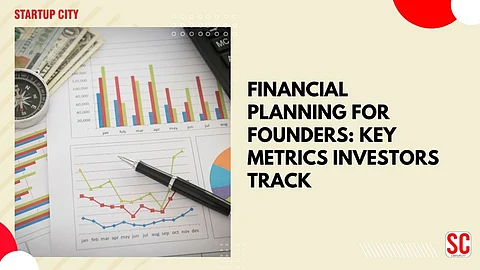

Financial Planning for Founders
“What gets measured gets managed.”
– Peter Drucker
When you're building a startup, the journey from bootstrapped hustle to VC-backed rocketship can be thrilling—but also overwhelming. There’s no shortage of advice on product-market fit, hiring, or branding. But financial planning for founders? That’s often overlooked—until investors start asking the tough questions.
If you're a startup founder, let me be brutally honest: investors don’t fund ideas—they fund numbers.
In my experience speaking with VCs, angel investors, and financial advisors, the startups that secure funding faster are the ones whose founders understand their numbers inside out. So let me break down the key financial metrics investors track—and how you can use them to not just raise capital, but lead with clarity.
You’re not alone if the phrase “financial metrics” feels a little daunting. Many early-stage founders are product geniuses, marketing ninjas, or tech whizzes—but finance? It often feels like a foreign language.
Here’s the secret: mastering just a few key numbers gives you unmatched control over your business—and shows investors you’re serious.
Think of financial planning as your startup’s GPS. It helps you:
Forecast cash needs before you run dry.
Make confident decisions about hiring, expansion, and marketing.
Attract serious investors with hard data—not just hopeful pitches.
Let’s dive into the metrics that can make or break your fundraising round.
Your burn rate is how much money your startup is spending each month. Your runway is how long you can keep operating at that burn rate before the cash runs out.
Example:
If you’re spending ₹10 lakhs per month and have ₹60 lakhs in the bank, you’ve got a 6-month runway.
Why Investors Care: It tells them how urgently you need funding—and how efficiently you're managing resources.
Pro Tip: Keep at least 12–18 months of runway post-funding to stay out of desperation mode.
These are the darlings of SaaS and subscription businesses.
MRR is your predictable monthly income.
ARR is just MRR x 12.
Why This Matters:
Investors love predictable revenue. If your MRR is growing steadily, it's a strong signal of product-market fit.
Real Example:
Freshworks, before its IPO, showcased powerful MRR growth as proof of global scalability. That data opened investor doors wide.
How much are you spending to acquire one paying customer?
Calculate it as:
Investor Insight: High CAC without a matching Lifetime Value (LTV) means your business is leaking money.
This is the total revenue you expect from a customer before they churn.
If you’re spending ₹1,000 to acquire a customer and earn ₹5,000 over time—that’s gold.
How much money do you keep after covering the cost of goods/services?
Formula:
A strong gross margin (ideally 60%+) signals your business has scalability baked in.
Especially for SaaS or subscription models, your churn rate tells you how many customers you’re losing.
Show that you’re not just earning—but scaling month-on-month. A consistent 10–20% MRR growth? You’ll be investor catnip.
This refers to profit per unit of product/service sold. If your unit economics are positive early, your business model is solid.
Earnings Before Interest, Taxes, Depreciation, and Amortization. It gives investors a view of core profitability.
I’ve seen too many decks filled with fluffy buzzwords but no numbers.
Here’s how you should showcase your financials:
Visuals win. Use clean, simple graphs to show MRR growth, CAC vs LTV, and runway.
Tell a story. For example:
“Our CAC dropped 20% after refining our targeting strategy—leading to a 30% improvement in LTV.”
Be transparent. If your burn is high, explain what it's funding (product development, team growth, etc.).
Show projections. Backed by logic, not just hope.
You don’t need to be a CFO to master these. Here are some tools I recommend:
QuickBooks or Zoho Books – For accounting
Google Sheets + Templates – For forecasts and dashboards
Baremetrics / ChartMogul – For SaaS metrics
Pitch.com or Canva – For investor-ready visual reports
Razorpay, one of India’s fintech unicorns, wasn’t always a unicorn. Their founders deeply understood cash flows, burn, and margins—giving investors like Tiger Global confidence early on.
They didn’t chase valuation—they tracked metrics, managed runway, and grew smartly. That’s what separated them.
Do I know exactly how long our runway is?
Are we acquiring customers efficiently?
What will it take to double our MRR in 6 months?
Is our CAC sustainable as we scale?
Take time to answer these honestly. Your startup’s future depends on it.
Let me leave you with this thought:
Understanding financial metrics isn’t just about impressing investors. It’s about taking ownership of your vision, making better decisions, and building a company that lasts.
So whether you're in your seed round, scaling to Series B, or bootstrapping proudly—these numbers are your compass.
Now it’s your turn.
Review your financial metrics this week.
Identify where you can improve.
Build investor trust through clarity and data.
You’ve got this—and the financial know-how to back it up.